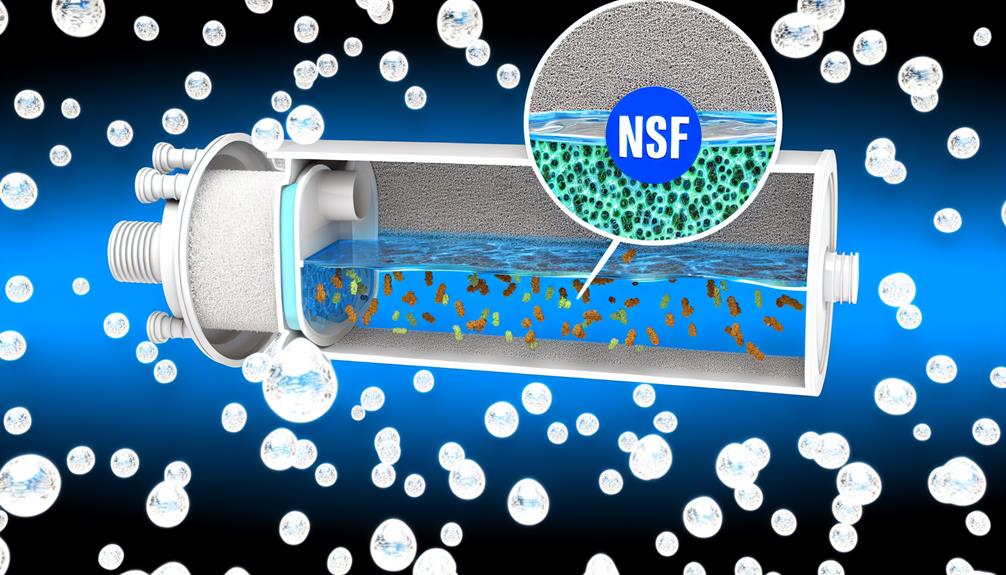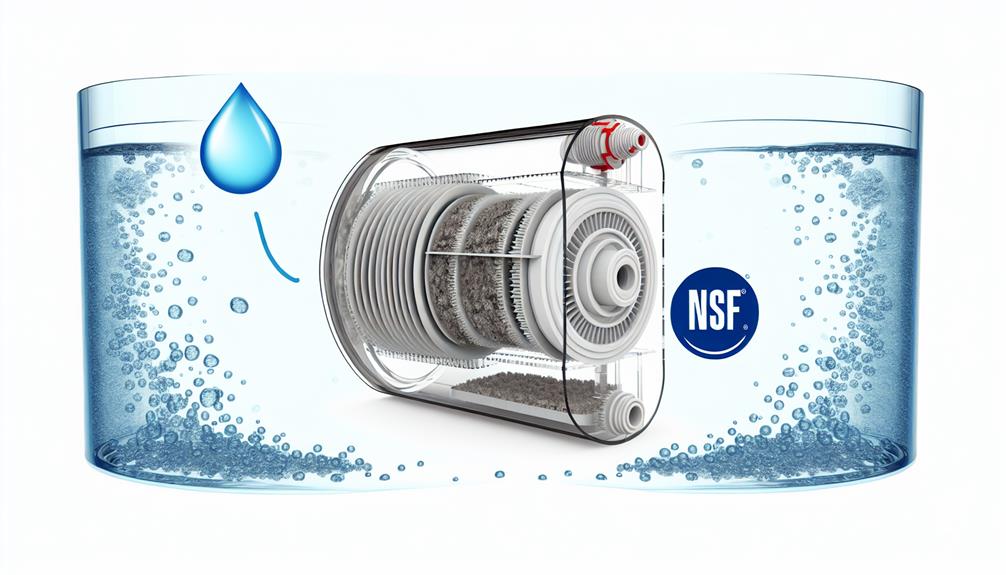Navigating the sea of water filters on the market, you're bound to encounter the term NSF certification—a beacon of credibility in a storm of product claims. As you chart your course toward selecting the best water filter, it's essential to understand the six key NSF certification standards that serve as lighthouses, guiding you to safe and effective choices.
NSF/ANSI 42 and 53, for instance, shine their lights on aesthetic and health-related contaminants, respectively, but what about the standards that govern emerging contaminants, or the ones that ensure UV purification isn't a siren's call? Grasping the nuances of these certifications will arm you with the knowledge you need to make an informed decision.
Yet, the intricacies of these standards are not as straightforward as they might appear, and it's vital to navigate these waters with a discerning eye to truly ensure your water filter meets your expectations for purity and safety.
Understanding NSF/ANSI Standard 42
When selecting a water filtration system, it's crucial to understand that NSF/ANSI Standard 42 specifically targets the aesthetic aspects of drinking water, such as taste and odor, by setting stringent requirements for the reduction of non-health-related contaminants. This certification ensures that water filter systems adhere to established water treatment standards for material safety and accurately fulfill contaminant reduction claims.
Systems certified under NSF/ANSI Standard 42 are primarily designed to mitigate aesthetic impurities, including the presence of chlorine, which can significantly affect water's taste and odor. These systems, whether implemented at the point-of-use or point-of-entry, often utilize adsorption and filtration processes, with carbon filters being a common technology employed.
Moreover, NSF/ANSI Standard 42 classifies the level of particulate reduction into different classes, addressing a spectrum of particulate sizes from coarse to submicron levels. It's important to note, however, that achieving NSF certification under this standard indicates that a system meets the minimum required reduction levels for specified contaminants, but it doesn't guarantee the complete removal of all possible impurities. As such, it's imperative to review the specific NSF Standards to ascertain the precise efficacy of any given Drinking Water Treatment Unit.
Significance of NSF/ANSI Standard 53
You must understand that NSF/ANSI Standard 53 is critical because it specifically addresses contaminants with known health risks.
It requires rigorous testing to ensure filters reduce harmful impurities such as lead and Cryptosporidium to safe levels.
As you evaluate water filters, certification to this standard is a reliable indicator of a filter's performance in protecting health.
Reducing Health-Related Contaminants
To safeguard human health, NSF/ANSI Standard 53 certification is essential as it ensures the reduction of hazardous contaminants such as lead, arsenic, and VOCs from drinking water.
When you select drinking water filters, it's critical to check if they're certified to reduce specific contaminants of health concern. This NSF testing and certification process verifies the filters' effectiveness against harmful contaminants that cause serious health effects.
These Water Filter Standards are stringent, necessitating precise technology such as carbon filtration to meet the criteria for specific contaminant reduction.
Health Effect Impurities Testing
Understanding the importance of NSF/ANSI Standard 53, it's clear that the rigorous testing for health effect impurities is a cornerstone in certifying the safety of water filters. This standard is critical in driving the certification process, ensuring that water filters meet stringent requirements for contaminant reduction, safeguarding public health.
Here's what you need to know about NSF/ANSI Standard 53:
- Contaminant Scope: Targets health-related impurities, including arsenic, lead, VOCs, and parasites like Cryptosporidium and Giardia.
- Testing Rigor: Employs detailed protocols to verify filters effectively reduce specified contaminants to levels that aren't harmful to health.
- Technology Validation: Validates carbon filtration and other technologies, confirming their effectiveness in achieving the health safety standards required for certification.
Filter Performance Verification
Why is NSF/ANSI Standard 53 essential?
It serves as a benchmark for verifying the performance of water filters in reducing health-related contaminants, ensuring that products adhere to established safety and efficacy criteria.
When a filter system is certified under this standard, it signifies the product has undergone rigorous testing and the test results support claims of reducing specific impurities, such as chlorine, lead, and VOCs.
This certification applies to both point-of-use and point-of-entry treatment systems.
As you evaluate water treatment products, look for NSF/ANSI Standard 53 certification to ensure the filters you select can effectively reduce health-related contaminants.
Certified products meet stringent requirements, giving you confidence in the performance and safety of your water treatment solution.
Overview of NSF/ANSI Standard 58
You must understand that NSF/ANSI Standard 58 sets the benchmark for the performance of Reverse Osmosis Systems.
It confirms the system's ability to reduce specific contaminants to levels deemed safe by Health Canada and the EPA.
The standard also ensures the integrity of system components, providing assurance that these filters perform reliably over time.
Reverse Osmosis Performance
Reverse osmosis systems, governed by NSF/ANSI Standard 58, utilize pressure differentials and semi-permeable membranes to effectively filter a wide spectrum of contaminants from drinking water. To ensure your water quality meets precise standards, you'll want to look for NSF certified water filtration products. This certification indicates rigorous testing conducted to verify system manufacturers' product performance claims.
Here's what you need to know about the performance of NSF certified reverse osmosis systems:
- Contaminant Reduction: They're designed to remove specific contaminants that cause negative health effects, including those regulated by Health Canada and the EPA.
- System Components: These systems include additional filters to enhance purification on both sides of the membrane.
- Performance Verification: The NSF mark signifies compliance with NSF/ANSI Standard 58, confirming the system's effectiveness against a broad range of contaminants.
Contaminant Reduction Claims
Building on the assurance provided by NSF/ANSI Standard 58 certification, let's examine the specific contaminant reduction claims that underscore the performance of reverse osmosis systems. This standard is pivotal in establishing the related contaminant reduction performance for systems that reduce a spectrum of harmful substances, including lead, fluoride, and nitrates. By adhering to these Standards for Water Treatment, products can reduce harmful components to levels mandated by Health Canada and the EPA, bolstering both reduction and health benefits.
Moreover, when water system manufacturers' product lines achieve NSF/ANSI 58 certification, they assure both public and private drinking water consumers of superior drinking water filtration. NSF Can Help Certify Microfilter technologies integral to these systems, ensuring that they meet or exceed established contaminant reduction thresholds.
System Component Integrity
System Component Integrity, as mandated by NSF/ANSI Standard 58, is crucial in ensuring that every part of a reverse osmosis system functions cohesively and effectively to reduce a broad range of contaminants.
Here's what you need to know:
- Material Safety: NSF certification affirms that all components meet strict material safety standards, ensuring they don't leach harmful substances into your water.
- Solid Carbon Block Filter: Integral to the system, it works alongside the reverse osmosis membrane to provide additional contaminant reduction, as established by NSF.
- POU and POE Systems: NSF offers a unique evaluation, demonstrating through product test results that both point-of-use and point-of-entry systems designed to reduce impurities uphold public health and safety.
These elements collectively establish minimum requirements, securing the integrity of your drinking water filter system.
Essentials of NSF/ANSI Standard 401
Understanding NSF/ANSI Standard 401 is crucial, as it specifically addresses the reduction of emerging contaminants, including pharmaceuticals and pesticides, in water filtration systems. This standard, established by the NSF Drinking Water Treatment Units (NSF DWTU), ensures that a treatment system not only tackles traditional pollutants but also those that have only recently been recognized as threats to material safety and public health.
When you consult the NSF database, you'll find that carbon filters are pivotal for meeting the stringent requirements of Standard 401. These filters are designed to adsorb minute traces of organic compounds, offering additional contaminant reduction capabilities essential for compliance. Moreover, Standard 401-certified products are rigorously tested to ensure they can effectively remove specific emerging contaminants that may not be regulated by the Safe Drinking Water Act but are found in public water supplies.
For Point-of-Entry (POE) systems designed to treat water for an entire building or residence, the adherence to Standard 401 signifies a higher level of protection. It's not just about meeting minimum expectations for contaminant reduction; it's about ensuring a treatment system can address a broader spectrum of potential risks, safeguarding water quality against both known and emerging threats.
Role of NSF/ANSI Standard 55
NSF/ANSI Standard 55 plays a pivotal role in certifying Ultraviolet Treatment Systems, ensuring they effectively neutralize harmful microorganisms in drinking water. As a component of public health protection, this standard is critical for establishing the efficacy of UV treatment systems.
Developed by the National Sanitation Foundation (NSF) in conjunction with the American National Standards Institute (ANSI), Standard 55 sets the benchmark for performance, safety, and reliability of systems designed to purify drinking water using ultraviolet light.
Here's what you need to know about NSF/ANSI Standard 55:
- Class A and Class B: Standard 55 categorizes UV treatment systems into two classes. Class A systems are designed to disinfect water that's known or suspected to be contaminated, making it safe for drinking. Class B systems, on the other hand, are meant for supplemental treatment of disinfected water to reduce non-pathogenic microorganisms.
- Certification Process: Systems that meet or exceed the requirements of NSF/ANSI Standard 55 undergo rigorous testing and are then certified. This certification assures that the UV treatment systems perform effectively to neutralize bacteria, viruses, and cysts in the water.
- Public Health Assurance: Certified systems under Standard 55 provide an extra layer of defense against waterborne diseases. By adhering to these standards, manufacturers contribute to safeguarding public health through enhanced water quality.
Importance of NSF P231 Certification
Recognizing the critical role of water filtration in ensuring microbiological safety, NSF P231 certification emerges as a vital benchmark for filters used in environments such as healthcare facilities and food services. This protocol, developed by NSF in collaboration with the Environmental Protection Agency, verifies the efficacy of drinking water filters in treating or reducing microbiological contaminants. By meeting NSF P231 standards, manufacturers signal their commitment to protect drinking water and, consequently, public health.
As you consider water filters for institutional settings, including prisons and mental health facilities, it's essential to demand NSF P231 certification. This certification ensures the drinking water filter has undergone rigorous testing, simulating worst-case conditions such as extreme temperatures and high levels of organic matter. Such thorough evaluation guarantees that the filter's performance aligns with the stringent safety requirements necessary in these sensitive environments.
Voluntary testing for NSF P231 certification allows manufacturers to demonstrate their filters' capacity to protect public health. As a stakeholder in the safety of drinking water, you're empowered to make informed decisions about the products you use. Insisting on NSF P231-certified filters is a prudent step to safeguard against microbiological threats in water, reinforcing the overarching goal of NSF to maintain and promote public health standards.

